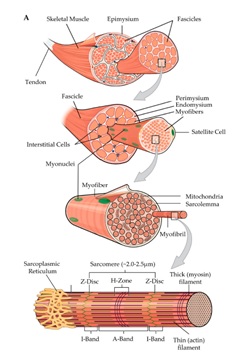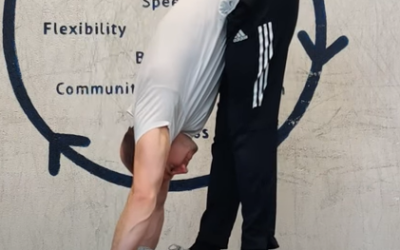I find this question interesting because we often, myself included, assume a person is less flexible, if they happen to have a bigger build – however, it’s not always the case. This is even though several studied have found a correlation between increased muscle mass and increased stiffness or reduced ROM (Neto et al. 2013; Ryan et al. 2009; Suga et al. 2021).
One of the reasons why you can still be very flexible, even with a large amount of muscle, is that muscle morphology isn’t the only factors that affect flexibility – another important factor is stretch tolerance, which I won’t be getting more into here (Check out this post if you want to read about the what happens when we get more flexible). It should also be noted that strength training can be an effective way of increasing flexibility (Afonso et al. 2021), even though you might increase muscle mass at the same time.
In this post I’ll be going over why an increase in muscle mass, might not always be bad for flexibility as well as give you some very basic pointers about how to approach strength training if you want to maintain or even increase flexibility through strength training.
Skeletal muscles are made up of bundles of muscle fibers called fascicles, fascicles are made of bundles of myofibrils or muscle fibers (Jorgenson et al. 2020). Around the muscle fibers, there are layer of connective tissue – together with the muscle fibers, this makes the muscle work kind of like an elastic band when pulled, even when the muscle is relaxed.
The fascicles can increase size in 2 ways; they can get thicker (this is called radial hypertrophy) – this would equate to getting a thicker elastic band – you’ll need more force to stretch it out. This is why an increase in muscle mass, can affect flexibility negatively.
Fascicles can also increase size by growing in length (this is called longitudinal hypertrophy). This would be the same as getting a longer elastic band. It’s still as stiff, but it can be stretched further if we pull with the same amount of force. If the muscle mass is increased this way, it could have a positive effect on flexibility – Several studies have found that flexible individuals have longer fascicles compared with normal individuals (Blazevich et al. 2012; Moltubakk et al. 2018), while other have found a correlation between fascicle length and reduced passive resistance to stretch (Blazevich et al. 2007) and ROM in young males (Hirata et al. 2020).

Skeletal muscles can be structures in different way, in regards to how the muscle fibers are oriented in relation to the tendon. Overall, we can differ between muscles parallel muscles where the fibers are going more less straight from tendon to tendon (example A in figure 2) and pennate muscles, where the fibers are attached obliquely to the tendon (exambe B, C, and D in figure 2).

This is reflected in numerous studies that have found an association between whole muscle aCSA and fascicle length, among others a systematic review by Ryoichi Ema et al. (2016) that included data from 38 independent studies.
It seems, that an increase in aCSA can be caused by both radial and longitudinal hypertrophy in pennate muscles.
An increase in muscle aCSA caused solely by radial hypertrophy would have a negative effect on flexibility while an increase in muscle aCSA due to longitudinal hypertrophy, could have a positive effect on flexibility.
So in parallel muscles, an increase in muscle size will most likely have a negative effect on flexibility. In pennate muscles, the effects of increasing muscle size on flexibility, will depend on the mechanism behind the hypertrophy, whether it’s caused mostly by longitudinal or radial hypertrophy.
If you want to strength train and grow bigger muscles without limiting your flexibility, it could be possible by maximizing hypertrophy through longitudinal hypertrophy. If you want to read more about how to increase flexibility through strength training, I wrote a blog post about this subject, that you can find here – but the main takeaway, is that you’ll want to make sure to train your muscles at their longest range.
Referencer:
Afonso, J., R. Ramirez-Campillo, J. Moscão, T. Rocha, R. Zacca, A. Martins, A. A. Milheiro, J. Ferreira, H. Sarmento, and F. M. Clemente. 2021. “Strength Training versus Stretching for Improving Range of Motion: A Systematic Review and Meta-Analysis.” Healthcare (Basel) 9 (4). https://doi.org/10.3390/healthcare9040427.
Alegre, L. M., A. Ferri-Morales, R. Rodriguez-Casares, and X. Aguado. 2014. “Effects of isometric training on the knee extensor moment-angle relationship and vastus lateralis muscle architecture.” Eur J Appl Physiol 114 (11): 2437-46. https://doi.org/10.1007/s00421-014-2967-x. https://www.ncbi.nlm.nih.gov/pubmed/25099962.
Blazevich, A. J., D. Cannavan, D. R. Coleman, and S. Horne. 2007. “Influence of concentric and eccentric resistance training on architectural adaptation in human quadriceps muscles.” J Appl Physiol (1985) 103 (5): 1565-75. https://doi.org/10.1152/japplphysiol.00578.2007. https://www.ncbi.nlm.nih.gov/pubmed/17717119.
Blazevich, A. J., D. Cannavan, C. M. Waugh, F. Fath, S. C. Miller, and A. D. Kay. 2012. “Neuromuscular factors influencing the maximum stretch limit of the human plantar flexors.” J Appl Physiol (1985) 113 (9): 1446-55. https://doi.org/10.1152/japplphysiol.00882.2012. https://www.ncbi.nlm.nih.gov/pubmed/22923509.
Ema, R., T. Wakahara, N. Miyamoto, H. Kanehisa, and Y. Kawakami. 2013. “Inhomogeneous architectural changes of the quadriceps femoris induced by resistance training.” Eur J Appl Physiol 113 (11): 2691-703. https://doi.org/10.1007/s00421-013-2700-1. https://www.ncbi.nlm.nih.gov/pubmed/23949789.
Ema, Ryoichi, Ryota Akagi, Taku Wakahara, and Yasuo Kawakami. 2016. “Training-induced changes in architecture of human skeletal muscles: Current evidence and unresolved issues.” The Journal of Physical Fitness and Sports Medicine 5 (1): 37-46. https://doi.org/10.7600/jpfsm.5.37.
Erskine, R. M., D. A. Jones, A. G. Williams, C. E. Stewart, and H. Degens. 2010. “Inter-individual variability in the adaptation of human muscle specific tension to progressive resistance training.” Eur J Appl Physiol 110 (6): 1117-25. https://doi.org/10.1007/s00421-010-1601-9. https://www.ncbi.nlm.nih.gov/pubmed/20703498.
Hirata, K., R. Yamadera, and R. Akagi. 2020. “Associations between Range of Motion and Tissue Stiffness in Young and Older People.” Med Sci Sports Exerc 52 (10): 2179-2188. https://doi.org/10.1249/mss.0000000000002360.
Jorgenson, K. W., S. M. Phillips, and T. A. Hornberger. 2020. “Identifying the Structural Adaptations that Drive the Mechanical Load-Induced Growth of Skeletal Muscle: A Scoping Review.” Cells 9 (7). https://doi.org/10.3390/cells9071658.
Kawakami, Y., T. Abe, S. Y. Kuno, and T. Fukunaga. 1995. “Training-induced changes in muscle architecture and specific tension.” Eur J Appl Physiol Occup Physiol 72 (1-2): 37-43. https://doi.org/10.1007/BF00964112. https://www.ncbi.nlm.nih.gov/pubmed/8789568.
Magnusson, S. P., E. B. Simonsen, P. Aagaard, J. Boesen, F. Johannsen, and M. Kjaer. 1997. “Determinants of musculoskeletal flexibility: viscoelastic properties, cross-sectional area, EMG and stretch tolerance.” Scandinavian Journal of Medicine & Science in Sports 7 (4): 195-202. https://doi.org/https://doi.org/10.1111/j.1600-0838.1997.tb00139.x. https://onlinelibrary.wiley.com/doi/abs/10.1111/j.1600-0838.1997.tb00139.x.
Moltubakk, M. M., M. M. Magulas, F. O. Villars, O. R. Seynnes, and J. Bojsen-Moller. 2018. “Specialized properties of the triceps surae muscle-tendon unit in professional ballet dancers.” Scand J Med Sci Sports 28 (9): 2023-2034. https://doi.org/10.1111/sms.13207. https://www.ncbi.nlm.nih.gov/pubmed/29723911.
Neto, T., S. Freitas, J. Vaz, A. M. Silva, P. Mil-Homens, and A. I. Carita. 2013. “Lower limb body composition is associated to knee passive extension torque-angle response.” Springerplus 2: 403. https://doi.org/10.1186/2193-1801-2-403.
Orlandi D., Perugin Bernardi S. 2015. Normal Anatomy and Biomechanics.: Springer.
Ryan, E. D., T. J. Herda, P. B. Costa, J. M. Defreitas, T. W. Beck, J. R. Stout, and J. T. Cramer. 2009. “Passive properties of the muscle-tendon unit: the influence of muscle cross-sectional area.” Muscle Nerve 39 (2): 227-9. https://doi.org/10.1002/mus.21218.
Suga, T., M. Terada, K. Tomoo, Y. Miyake, T. Tanaka, H. Ueno, A. Nagano, and T. Isaka. 2021. “Association between plantar flexor muscle volume and dorsiflexion flexibility in healthy young males: ultrasonography and magnetic resonance imaging studies.” BMC Sports Sci Med Rehabil 13 (1): 8. https://doi.org/10.1186/s13102-021-00233-z.


0 kommentarer